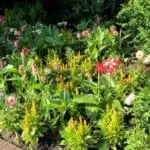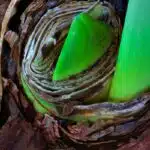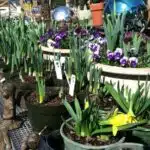As the days become shorter and the chill in the air begins to linger, you may feel as though it’s too late to add anything more to your garden. But did you know that September is one of the best months for planting? With just a few weeks left before autumn takes hold and winter is on its way, now is the perfect time to plant some delicious vegetables and gorgeous flowers.
Picture yourself enjoying a warm cup of coffee in your backyard, admiring the beautiful blooms and fragrant herbs dotting your garden. Imagine harvesting ripe tomatoes or picking bright bouquets from your flowerbeds – all thanks to what you planted this month. Now’s the time to get started!
September can be an ideal month for gardening. It’s not too hot nor too cold, with enough sun and rain so that plants can take root before winter sets in. In this article, we’ll explore ten of the best vegetables and flowers that you can plant in September. We’ll discuss when they should be sown and provide helpful tips on planting them so that you can make sure your garden is a success.
The best vegetables and flowers to plant in September will depend on your location and climate. However, here are some options that tend to thrive when planted during this time:
- Lettuce – cool-season crop that can be planted in September
- Spinach – another cool-season crop that can be planted in September
- Kale – a hardy leafy green that grows well in cooler temperatures
- Broccoli – can be planted in late summer for a fall harvest
- Cauliflower – similar to broccoli, it can be planted in late summer for a fall harvest
- Carrots – a root vegetable that can be sown in the fall for a late fall or early winter harvest
- Beets – another root vegetable that can be sown in the fall for a late fall or early winter harvest
- Radishes – fast-growing and can be planted throughout the fall
- Green onions – can be planted in the fall for a late fall or early winter harvest
- Garlic – planted in fall and overwintered to be harvested the following summer
- Snow peas – can be planted in September for a fall harvest
- Cabbage – can be planted in late summer for a fall harvest
- Arugula – another cool-season crop that can be planted in September
- Swiss chard – hardy leafy green that can be planted in late summer or early fall
- Turnips – a root vegetable that can be sown in the fall for a late fall or early winter harvest
- Peonies – a perennial flower that can be planted in the fall for a spring bloom
- Daffodils – another perennial flower that can be planted in the fall for a spring bloom
- Tulips – can also be planted in the fall for a spring bloom
- Irises – can be planted in the fall for a spring bloom
- Pansies – an annual flower that can be planted in the fall for winter and early spring blooms
- Violas – similar to pansies, they can be planted in the fall for winter and early spring blooms
Make sure to check your local planting schedule and climate zone before planting to ensure the best results.
1. Reasons To Plant In September
In the summer’s last hurrah, September ushers in a sense of renewal. With a new season comes the promise of fresh harvests and vibrant flowers. Planting in September is an opportunity to jumpstart your garden for the upcoming year.
Cool-season vegetables are the stars of the show when it comes to late-summer planting. Broccoli, kale, and lettuce all thrive in cooler temperatures, making them ideal for a fall harvest. Root crops such as radishes and carrots also enjoy the slightly cooler climate. They can be planted from seed or from starter plants in early September, just before temperatures begin to dip.
Flowers should also be considered for planting in September. Asters and chrysanthemums will bloom until the first frost, while mums are best planted in late September so they can bloom throughout autumn months. Planting perennials now will provide you with beautiful blooms year after year.
2. Cool-Season Vegetables To Plant In September
As the days begin to cool, now is the perfect time to get out into the garden and plant some cool-season vegetables. With a little planning and preparation, you can enjoy a bountiful harvest of fresh produce come autumn. Here are ten of the best vegetables and flowers to plant in September.
From leafy greens like kale and spinach to root veggies like beets, carrots, and potatoes, there are plenty of options for planting in September. If you’re looking for something with more color, consider planting lettuce in shades of green, red, and purple. Other popular choices include broccoli, cauliflower, cabbage, turnips, radishes, peas, and Swiss chard.
To add extra beauty to your garden beds this fall season, why not plant colorful blooms? Chrysanthemums make an excellent choice with their long-lasting blooms that come in many colors from yellow to white to lavender. Pansies also provide lovely blooms in shades such as blue and orange with their delicate petals. Asters are another great option with their star-shaped petals that come in pink or purple hues.
With these ten vegetables and flowers planted this month, you’ll have a garden bursting with life come autumn! Now let’s look at some warm-season vegetables that can be planted in September for a harvest later on this year.
3. Warm-Season Vegetables To Plant In September
The warm-season vegetables to plant in September are a great addition to any garden. They tend to thrive in the cooler weather of autumn, so they can be planted throughout the month and into October. These vegetables include tomatoes, peppers, beans, cucumbers, squash, and more. Planting these vegetables now gives you time for them to get established before winter and will ensure a healthy harvest come spring.
When planting warm-season vegetables in September, make sure to prepare your soil with compost or fertilizer first. This will give the plants all the nutrients they need for growth. Then you can sow your seeds directly into the soil or start them indoors about 6 weeks before transplanting them outdoors. Water regularly when the soil is dry and provide adequate sunlight so that your plants will flourish.
Finally, use mulch around your vegetable plants which helps retain moisture in the soil and keeps weeds away. Keep an eye out for pests like aphids and caterpillars that may feed on your crops. If necessary, use an organic pesticide or insecticide as soon as you spot any signs of infestation. With these tips in mind, you’re sure to have a successful harvest!
4. Tips For Planting Vegetables In September
Have you ever wondered what vegetables to plant in September? It’s a great time of year to get your garden started, and there are several tips that can help you make the most of the season. Let’s take a look at how to successfully grow vegetables in September.
When planting in September, it’s important to pay attention to the type of soil and sunlight conditions in your area. Make sure that your soil is well-drained and has plenty of nutrients for your plants. You’ll also want to consider what kind of light exposure your plants need, as some varieties require more sun than others.
It’s also important to water your plants properly when planting in September. Aim for deep watering rather than frequent shallow watering as this will encourage healthy root growth and stronger plants overall. Remember not to over water as this can lead to root rot and other diseases.
By following these tips and doing a bit of research into what vegetables do best in your area during this time of year, you can be sure that your efforts will be rewarded with a successful harvest!
5. Flowers To Plant In September
Flowers are a great way to add color and beauty to your outdoor space. Planting flowers in September is an ideal time, as the weather is cooler and the soil is still warm enough for them to grow. Many perennial flowers are a great choice for planting in September, as they will return year after year with minimal care.
Some of the best flowers to plant in September include lilies, coneflowers, coreopsis, phlox, asters, black-eyed Susans, and bee balm. These perennials come in a variety of colors and sizes to suit any garden design. They also offer plenty of late season blooms that will brighten up your garden until frost arrives. Additionally, many of these plants are also beneficial for pollinators like bees and butterflies.
By planting perennial flowers in September, you can enjoy their beauty all season long without having to replant each year. It’s important to consider soil type and light requirements when choosing plants for your garden so that they have the best chance at thriving in their new home. With proper care and maintenance, these beautiful blooms will give you years of enjoyment while adding valuable texture and color to your landscape.
The benefits of planting perennial flowers in September are clear; not only do they provide gorgeous blooms throughout the season but they also attract beneficial pollinators like bees and butterflies while requiring minimal effort on your part!
6. Benefits Of Planting Perennial Flowers In September
Perennial flowers are a great addition to any garden, providing long-lasting beauty and texture. Planting perennial flowers in September can be beneficial in many ways. Firstly, the cooler temperatures of autumn make it easier for plants to become established. Secondly, there is usually ample rain available during this time which helps to nourish the soil and provide much needed moisture to the roots of the plants. Thirdly, since perennials tend to come back year after year once they are planted, they require minimal maintenance in comparison to annuals which must be replanted every season.
These advantages can make a big difference in the success rate of your flower beds. With perennial flowers, you do not have to worry about replanting each season and you can enjoy blooms for months on end! Additionally, these plants are often more resistant to diseases and pests than annuals so you don’t have to worry about them as much either.
These benefits make planting perennial flowers during September an excellent choice for gardeners who want vibrant colors and textures that will last throughout the year with minimal effort. However, for optimal results it is important to follow a few tips when planting perennials during this time of year.
7. Tips For Planting Perennial Flowers In September
The beauty of perennial flowers is that they bloom year after year, creating a vibrant and colorful display. Like the sun setting in the sky, these blooms offer a glimpse of solace in an ever-changing world. With the arrival of September, now is the perfect time to get planting!
To ensure your perennials thrive, be sure to choose varieties adapted to your region and give them plenty of space when planting. Planting them in well-drained soil with lots of organic matter will help provide essential nutrients for longer lasting blooms. Additionally, adding mulch can help keep moisture in while ensuring weeds are kept at bay.
When planting perennials, look for plants that flower successively throughout the season to create a continuous display of color. Take into consideration how much sunlight or shade each area receives and plan accordingly; this will ensure that you have the right combination to achieve an eye-catching landscape design. With just a few simple tips, you’ll be well on your way to a beautiful landscape filled with vibrant perennials come springtime!
8. Annual Flowers To Plant In September
When it comes to adding color to your garden in the fall, annual flowers are a great option. These types of flowers bloom continuously throughout the season and, with proper care, can provide vibrant colors even after the first frost. In this article, we will explore the benefits of planting annual flowers in September.
First and foremost, planting annuals in September will ensure they have enough time to establish themselves before winter sets in. This means that you don’t have to worry about them freezing and dying off. Additionally, these types of plants tend to be very hardy and can thrive in both sunny and shady spots. Annuals also require less water than perennials, making them ideal for those who want a low-maintenance garden.
For those looking for an easy way to add some color to their gardens this autumn, planting annuals is definitely worth considering. Not only do they provide a unique array of hues but they also take less effort to care for compared to other types of plants. With plenty of varieties available on the market, you’ll be sure to find something that suits your gardening needs as well as your budget.
Planting annual flowers in September has many advantages; now let’s look at some of the benefits in more depth.
9. Benefits Of Planting Annual Flowers In September
Feeling the heat of summer, September is an ideal time to start planting annual flowers. Whether you have a green thumb or not, it’s worth taking a shot at bringing some color and life into your garden. So what are the benefits of planting annual flowers in September? Let’s take a look.
To begin with, annual flowers come in vibrant colors and fragrances that will really put your yard over the top. Blossoming throughout the fall season, they can add a fresh breath of life to any garden. Additionally, they provide much-needed food for pollinators like bees and butterflies who cannot survive without them.
On top of that, these flowering plants are relatively easy to care for since they only last one growing season – meaning you won’t need to spend too much time and energy on maintenance as opposed to perennials which take more effort to keep alive year after year. Plus, most annual flowers bloom from late summer through autumn so you’ll be able to enjoy their beauty for longer than other types of plants.
All in all, there’s no doubt that planting annual flowers in September can bring new life and charm to your outdoor space – plus with their easy upkeep you’ll be able to reap their rewards all season long!
10. Tips For Planting Annual Flowers In September
When it comes to planting in september, annual flowers are a great choice. They can brighten up any landscape with their vibrant colors and add texture to the garden. There are many benefits of planting annuals that make them an ideal choice for September. Here are some tips for planting annual flowers in September.
First, it’s important to choose the right type of flower for your climate. Depending on where you live, you may need more sun or more shade when selecting your flowers. Consider the amount of sunlight your yard gets and choose accordingly. Secondly, be sure to water the plants regularly during the summer months, so they’re in good condition by the time autumn rolls around. This will help keep them from wilting in hot weather.
And lastly, consider adding compost and fertilizer to enrich the soil before planting annuals in September. This will give them a head start and ensure that they get all the nutrients they need throughout their growing season. With these tips and careful planning, you can have beautiful annual flowers blooming in no time!
With these tips and guidelines, you’re ready to get out there and plant those gorgeous annual flowers this September! Now let’s move on to looking at what bulbs are best suited for planting this month too!
11. Bulbs To Plant In September
There is something special about planting bulbs in the fall. It’s like a promise of the future, an anticipation of beauty when spring comes around. Just like a seed buried in the ground, planting bulbs gives us hope that life will return and flourish again after winter.
Planting bulbs in September has many benefits. Fall-planted bulbs usually emerge earlier than those planted in spring and are less likely to be damaged by late frosts or cold weather. Additionally, they require less maintenance and have a longer blooming period because they are already established before winter sets in.
These benefits make planting bulbs during autumn not only advantageous but also enjoyable for gardeners of all levels. In addition to giving your garden some extra color during the colder months, planting bulbs can provide a great opportunity to create unique displays with different sizes and colors of flowers. Plus, it’s an easy way to get creative with seasonal plantings!
12. Benefits Of Planting Bulbs In September
Many gardeners are unaware of the benefits of planting bulbs in September. While it is typically a time for harvesting and preparing for winter, this is actually an excellent month to start planting some of your favorite flowers and vegetables. For most areas, fall is the best time to get started with bulb planting as temperatures begin to drop and soil moisture levels increase.
The advantages of planting in September include more roots growing before winter sets in. This means that when warmer weather returns, plants have already had a chance to establish themselves and will be ready to bloom much sooner. Additionally, the cooler temperatures reduce stress on plants so they can focus their energy on root growth instead of flowering. More roots can also mean larger plants with more vibrant blooms.
Another great benefit is that you can get more out of each bulb by dividing them into smaller pieces, which will give you more coverage in your garden or flower bed. September also provides ideal conditions for many types of bulbs – including tulips, daffodils, crocus and allium – to flourish without having to worry about extreme heat or cold during their first season. With these factors in mind, it’s easy to see why planting bulbs in September can be beneficial for anyone looking to add some color and life to their outdoor spaces.
13. Tips For Planting Bulbs In September
When it comes to bulbs, planting in September is an excellent idea. The cooler temperatures, combined with more consistent rainfall, provide the perfect conditions for bulbs to take root and thrive. Plus, the mild weather helps ensure that the bulb won’t be exposed to too much heat or cold. As such, here are some helpful tips for planting bulbs in September.
First and foremost, make sure you choose quality bulbs that are free of disease and pests. It’s also a good idea to plant them in a raised bed or container that allows for proper drainage and ventilation. Additionally, you may want to consider adding a layer of mulch or compost on top of the soil before you plant your bulbs. This will help retain moisture and protect the roots from extreme temperatures and fluctuations in humidity.
Finally, it’s important to remember that while planting in September is ideal for bulbs, they still need regular maintenance throughout the growing season. Be sure to water regularly and add additional fertilization if necessary. With proper care and attention, you can enjoy an abundance of beautiful blooms come spring!
14. Harvesting And Storing Vegetables Planted In September
Harvesting and storing vegetables planted in September is an important part of gardening. It’s essential to ensure that the produce is stored properly, as this will help retain its freshness and nutritional value. If harvested too early or too late, vegetables can lose their flavor and texture.
The time to harvest depends on the variety of vegetable being grown. For example, certain varieties of tomatoes should be harvested when they are fully ripe, while carrots and potatoes should be harvested before they become over-mature. In addition, it’s important to check for any signs of disease before harvesting.
Once the vegetables have been harvested, it’s best to store them in a cool and dry place. This will help preserve their flavor and nutritional value for a longer period of time. Additionally, there are a variety of methods for preserving different kinds of vegetables; for instance, some can be blanched or frozen for future use. With careful preparation and storage techniques, you can enjoy the fruits (or veggies!) of your labor long after you’ve planted them in September!
These tips can help gardeners make the most out of their plantings this month – but sustainable gardening practices should also be taken into account when planning a garden in September.
15. Sustainable Gardening Practices For September Plantings
The journey of sustainable gardening is a voyage of discovery. It takes patience, hard work and commitment to explore the depths of our gardens in order to uncover their true potential. As we nurture our plants with our care and attention, it is important to remember the importance of sustainable practices when planting in September.
When embarking on this expedition, attention must be paid to the specific requirements for each type of plant – from temperature and sunlight needs, to soil composition and hydration levels. Through careful consideration and an understanding of the environment, gardeners can ensure that their plants flourish without causing harm or waste.
Just as a sailor navigates the seas with a compass, so do gardeners need their own ‘toolkit’ filled with sustainable strategies that will help them navigate the sometimes murky waters of gardening. Composting any organic matter such as kitchen scraps or yard debris can provide rich nutrients for plants while also reducing household waste. Rainwater collection systems are another great way to conserve water while providing valuable hydration for thirsty plants.
These simple yet effective techniques offer guidance for all intrepid gardeners as they set off on their journey towards a more sustainable future. With sustainability at its core, this voyage can be achieved through careful planning and thoughtful implementation – taking us one step closer to our ultimate destination: beautiful blooms and bountiful harvests!
Frequently Asked Questions
What Vegetables And Flowers Should I Plant If I Live In A Cold Climate?
Faced with the daunting task of knowing what vegetables and flowers to plant in September can be a difficult decision for many gardeners. But, thankfully, there are certain varieties that are ideal for cold weather climates. From vibrant blooms to nutrient-rich veggies, here’s a look at some of the best options for planting this fall season.
For starters, one of the most seasonal favorites is kale. This hardy green vegetable is sure to add a healthy dose of nutrition to any garden plot. Other great vegetables for colder climates include cauliflower, cabbage, Brussels sprouts and spinach. These vegetables can withstand temperatures as low as 20 degrees Fahrenheit and thrive in cooler months.
One cannot forget to mention flowers when talking about adding color to the garden! Snapdragons and pansies are excellent choices during this time of year. The delicate petals of snapdragons come in beautiful shades such as white and yellow while pansies provide a burst of bold colors such as purple and orange. Asters also offer a unique variety; its vibrant blooms create an ombre effect on the stem that’s simply enchanting!
Whether you’re looking to add a splash of color or nutritious veggies, there’s certainly something here that will fit your gardening needs this fall season! With these picks, you’ll be sure to create an eye-catching yet functional garden regardless of how cold it gets outside!
Should I Fertilize My Vegetables And Flowers Before Planting In September?
As the leaves turn from green to gold and the temperatures begin to drop, so too does the thought of prepping for autumn planting. Now’s the time to ask the all-important question: should I fertilize my vegetables and flowers before planting in September?
The answer is yes, fertilizing your plants will give them a better chance of surviving the cold winter months. Fertilizers can help strengthen their roots, providing them with essential nutrients to stay healthy and vibrant throughout the winter season. They also provide additional protection against pests, disease, and other environmental stressors. Plus, they’ll help your plants to look good when it comes time for spring blooms!
When it comes to fertilizing in September, there are a few things you should keep in mind. First, make sure that you’re using a fertilizer specifically designed for your type of plant or flower; different types require different nutrients. Additionally, be sure not to overdo it – too much fertilizer can burn or damage your plants! With a little bit of effort, you can ensure that your vegetables and flowers will thrive as autumn passes by.
How Often Should I Water My Plants In September?
When deciding what to plant in September, it’s important to consider how often you should water your plants. This is especially true for vegetables and flowers, which require frequent watering to survive. To ensure optimal growth, the amount of water needed depends on the type of plant and the climate in which it is planted.
It’s recommended to water vegetables and flowers twice per week during the summer months, though this may vary depending on your area. You should also take into consideration the weather conditions and adjust your watering schedule accordingly. If there has been a lot of rainfall recently, you may need to reduce the frequency of your watering. On the other hand, if it’s been very dry or hot, you should increase your watering schedule to keep your plants healthy.
Adding an organic fertilizer can also help promote healthy growth in vegetables and flowers during the autumn months. As well as providing essential nutrients, regular fertilizing can improve soil drainage and aeration, making it easier for roots to absorb moisture from surrounding soil. It’s best to apply fertilizer once every two weeks while following product instructions carefully. By taking care of your plants throughout September with adequate water and fertilizer, you can ensure they remain in good condition throughout fall and winter.
What Is The Best Soil For Growing Vegetables And Flowers In September?
When it comes to planting vegetables and flowers in September, the type of soil used can make a big difference. Take the case of Sarah, who wanted to create a beautiful flower garden for her backyard. She knew that her soil needed to be just right for the plants to thrive. After doing some research, Sarah found that the best soil for growing vegetables and flowers in September had good drainage, plenty of organic material, and an optimal pH level.
The primary step she took was to amend her existing soil with organic matter such as compost or well-rotted manure. This not only added nutrients but also improved drainage by loosening tightly packed soils. For example, incorporating sand into clay soils helps reduce compaction so water can move freely through it. Additionally, Sarah tested her soil’s pH level – if it was too alkaline or acidic, she adjusted it with the right fertilizer or lime mix to make sure her plants had enough calcium and magnesium ions for healthy growth.
Finally, Sarah ensured that her garden received enough water throughout September by setting up an irrigation system with a timer and sensors. This way she could keep track of how much moisture was available in the soil at all times and adjust accordingly. By taking these steps, Sarah created an ideal environment for her vegetables and flowers to flourish throughout the month of September.
How Do I Know When My Vegetable And Flower Plants Are Ready To Be Harvested?
Harvesting vegetables and flowers can be a tricky process, but it’s important to get it right. Knowing when to harvest your plants is key to ensuring they reach their full potential. So how do you tell when the time is right?
The most important thing to look out for is the ripeness of the fruit or flower. If vegetables like tomatoes, peppers, and squash are still green, they may need some more time on the vine. But if they are starting to turn color, they are likely ripe and ready for harvest. Similarly, with flowers like roses and zinnias, if their petals have fully opened up and bloomed, that’s a sign that they’re ready to be cut.
Another factor to consider is size – depending on the type of plant you’re growing, there may be a set size at which you should harvest them. Check the seed packet or label for information on how large your vegetable or flower should be before harvesting. Finally, paying attention to weather patterns can also help determine when it’s time to pick your produce – windy days can cause damage to delicate plants and extreme heat or cold can lead to wilting or frostbite.
By keeping an eye out for these signs of ripeness as well as looking out for any adverse weather conditions, you’ll know exactly when it’s time to pluck those veggies and blooms off the vine!
Conclusion
The final harvest of the season is just around the corner and with it comes an opportunity to reap the rewards of all your hard work in the garden this past summer. Planting vegetables and flowers in September is a great way to ensure that you have something to show for all your effort. With careful planning and attention to detail, you can have a bounty of delicious vegetables and beautiful flowers just waiting to be harvested.
Imagining the feeling of satisfaction that comes with picking those first ripe tomatoes, or deciding which flowers look best in your home’s vase, is enough to get anyone excited about planting their garden this September. Watching your plants grow throughout the fall months will give you a sense of accomplishment and pride. Plus, with proper care and maintenance, you can enjoy healthy vegetables and fragrant blooms until well into wintertime.
In short, whether you’re a seasoned gardener or just starting out, there are plenty of reasons why planting vegetables and flowers in September is a great idea. With some imagination and creativity, you can create a successful garden that will provide enjoyment for many months to come!





























